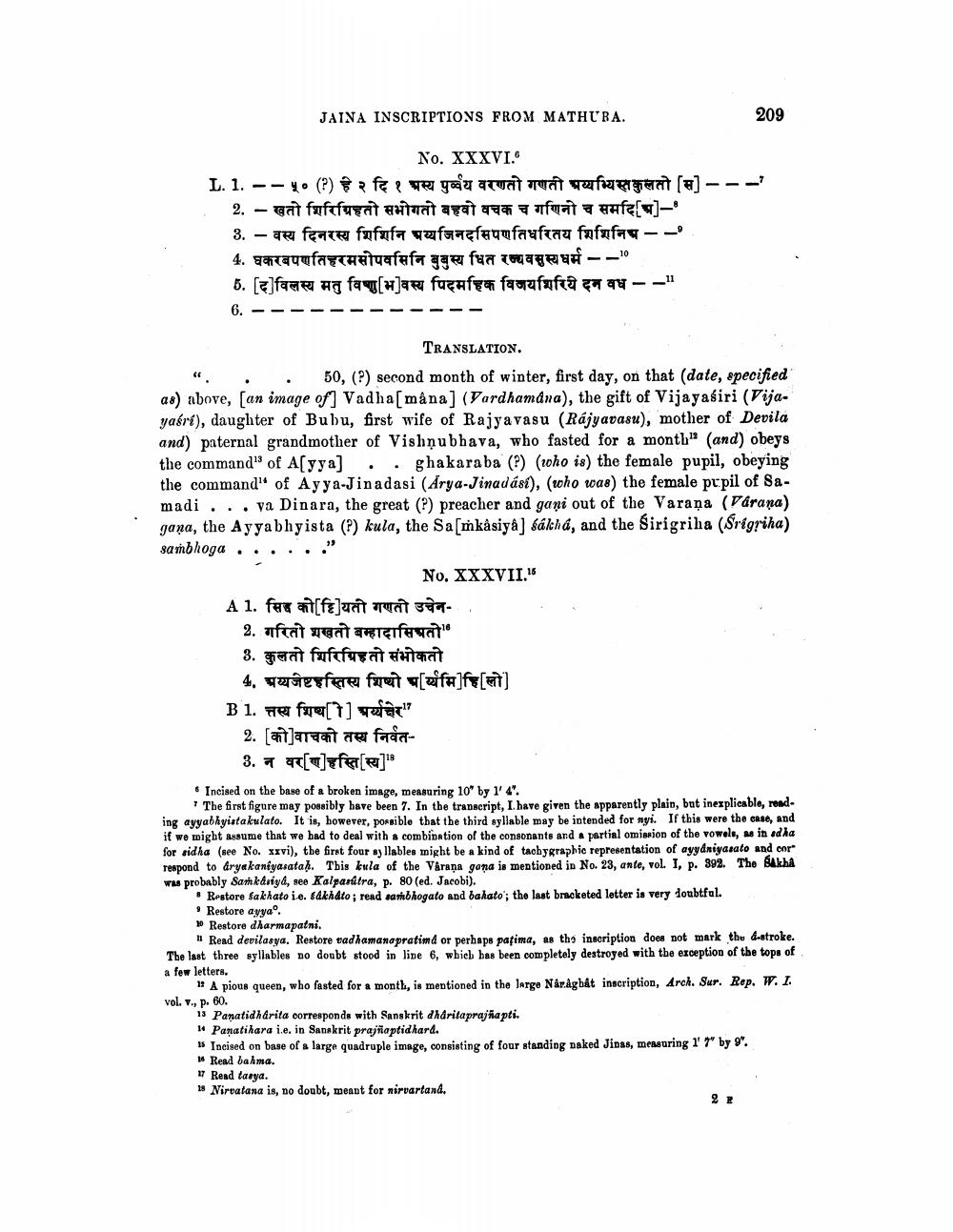________________
L. 1. 2.
No. XXXVI.
(?)
few yn newit wat warfawryant [v] · तो शिरिग्रहतो सभोगतो बहवो वचकच गणिनो च समदि[च] - au featu fafafa ufaaefauufauftau fafafa 4. घकरबपतिहरमसोपवसिनि बुबुस्य धित रज्य व सुस्य धर्म 5. [८] विलस्य मतु विष्णु [भ]वस्य मिहिक विषयमिरिये दन वध
3.
11 -
6.
——
JAINA INSCRIPTIONS FROM MATHURA.
-
No. XXXVII.15
A 1. fe ferit murit ever2. गरितो तो बाद"
3. कुलतो शिरिग्रहतो संभोकतो
4. quizferu faruit w[nifu]fw[vi]
B1. ww fir
2. [को] वाचको तय निर्वत
3. न वर च] हस्ति [य]"
--
10
TRANSLATION.
50, (?) second month of winter, first day, on that (date, specified" a) above, [an image of] Vadha[mâna] (Pardhamdwa), the gift of Vijayabiri (Vijayari), daughter of Bubu, first wife of Rajyavasu (Rájgarasu), mother of Devila and) paternal grandmother of Vishnubhava, who fasted for a month" (and) obeys the command of A[yya].. ghakaraba (?) (who is) the female pupil, obeying the command" of Ayya-Jinadasi (Arya-Jinadás), (who seas) the female pupil of 8amadi... va Dinara, the great (?) preacher and gani out of the Varana (Varana) gena, the Ayyabhyista (P) kala, the Sa[mkasiya] did, and the Sirigriha (Sigrita) sambhoga...
209
-7
Incised on the base of a broken image, measuring 10" by 1' 4".
The first figure may possibly have been 7. In the transcript, I. have given the apparently plain, but inexplicable, reading ayyabhyistakulato. It is, however, possible that the third syllable may be intended for nyi. If this were the case, and if we might assume that we had to deal with a combination of the consonants and a partial omission of the vowels, as in adha for sidha (see No. xxvi), the first four syllables might be a kind of tachygraphic representation of ayyaniyasato and cor respond to aryakaniyasatah. This kula of the Varana gana is mentioned in No. 23, ante, vol. I, p. 392. The Sakha was probably Samkasiya, see Kalpasútra, p. 80 (ed. Jacobi).
Restore Sakhato i.e. sakhato; read sambhogato and bahato; the last bracketed letter is very doubtful. Restore ayya.
10 Restore dharmapatni.
"Read devilasya. Restore vadhamanapratima or perhaps patima, as the inscription does not mark the 4-stroke. The last three syllables no doubt stood in line 6, which has been completely destroyed with the exception of the tops of a few letters.
2 E
1 A pious queen, who fasted for a month, is mentioned in the large Nârâghât inscription, Arch. Sur. Rep. W. I. vol. v., p. 60.
13 Panatidhárita corresponds with Sanskrit dhâritaprajñapti.
Panatihara i.e. in Sanskrit prajñaptidhara.
15 Incised on base of a large quadruple image, consisting of four standing naked Jinas, measuring 1' 7" by 9".
16 Read bahma.
17 Read tasya.
18 Nirvatana is, no doubt, meant for nirvartand.




